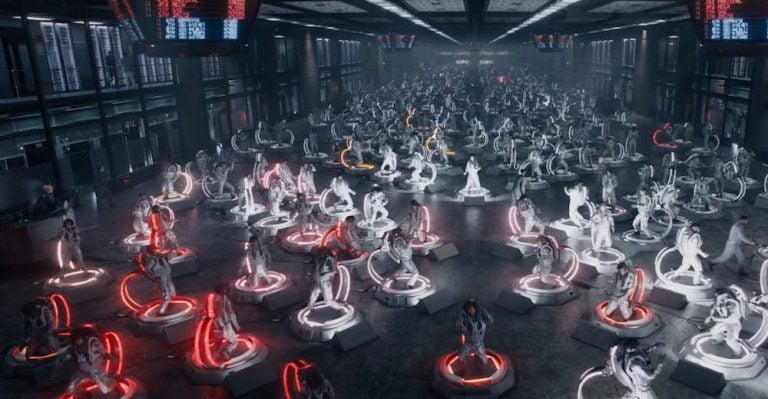“After five minutes of conversation there is twenty minutes of prayer. And the prayer is into iPhones and Samsung devices and Galaxies and iPads.” – Steven Spielberg, speaking to the New York Times.
There was a lot riding on Bruce the Shark. Built for a then-noteworthy quarter million, it was supposed to swim, jump, and bite terrified extras. On its first day Bruce immediately sank to the ocean floor. Facing a career ending flop, Steven Spielberg refocused – the fear would have to come not from seeing the shark, but from where the shark might be. Delays forced the opening into summer, which in 1975 was where weak and sickly pictures got left to perish. To the surprise of nervous studio heads, test audiences loved it, and so the legendary success of Jaws (and its accompanying business model) came to pass.
Two years later, Spielberg’s friend George Lucas released Star Wars, and thus began the age of the summer blockbuster. Sequels for popular films were a largely cynical exercise, and rarely involved their original creators. Where Spielberg feared creative stagnation, Lucas saw an opportunity – the franchise. Lucas took advantage of pessimistic producers and negotiated a share of the merchandising profits. Star Wars: A New Hope became a blueprint, a Campbellian work of emotional peaks and troughs that’s dynamic, toyetic, and endlessly reproducible.
What Star Wars provides is a universe (not just a world, but a universe) where every detail is available to the faithful.
No film before or since has been re-released quite so often, and in all likelihood this process will continue until the ocean laps at our proverbial doorstep. What Lucas learned is that each iteration must be bigger than the last. A shark, simply implied, will not do. Imagine a Jaws 7 where we’ve met the evil scientist that created the shark, exploded the lab, and made privy to the struggles of his entire extended family. The plot of the seventh Star Wars revolves around a Death Star even bigger than the previous two.
What Star Wars provides is a universe (not just a world, but a universe) where every detail is available to the faithful. Every character, no matter how minor, has a name and backstory. A colossal tower built on minutiae. In essence, it’s a story without mystery, ready for self-proclaimed geeks to bicker over whether it’s realistic for Boba Fett to get digested by the Sarlacc.
Enter Ernest Cline.
Love Music?
Get your daily dose of metal, rock, indie, pop, and everything else in between.
Cline developed a following for his work in the slam poetry scene, producing such notable works as ‘Nerd Porn Auteur’. His debut screenplay, Fanboys, followed a group in post-high school malaise who decide to steal a rough cut of The Phantom Menace before their friend dies of cancer. In the climactic scene, George Lucas, playing himself, gives them a quiz to prove their worth. To Cline, Star Wars is a devotional text, and geekdom is measured on the accumulation of information. The pleasure lies in nothing so base as story or character, but in recitation. It is not enough to simply love, one must be constantly seen demonstrating their love. Luckily enough, the church has a gift shop at the end of the tour.
If your iconography enters pop culture, then you can perpetuate branding without people actually having to watch your movie.
Ready Player One was subject to a bidding war before the book’s release (which, to be fair, was also the case for Jaws), and it’s easy to see why. It’s the one film you don’t have to put any work into getting people to care about, because the dazzling array of pop symbolism is built entirely from things the audience already knows. This is the end goal for intellectual property. If your iconography enters pop culture, then you can perpetuate branding without people actually having to watch your movie.
We’re in a post-content era, where promoting the interplay of iconography takes precedence over the product itself. Divorced from context, these figures can be used to promote a franchise by targeting people who would otherwise have no interest in the property. Disney promotes new Star Wars characters by releasing action figures months prior to the film’s release. The Twilight phenomenon popularized the notion of being on a fictional character’s ‘team’, the ins and outs of its four-film love triangle debated on social media. Newsmedia’s insistence on using Harry Potter references, which has (at best) a facile grasp of politics, keeps it in the cultural conversation a full decade past its use-by date.
The problem with this approach is that you might neglect to make a memorable film. Avatar made billions of dollars, but all most people remember is the blue people with LED tails. Ready Player One is nothing but iconography, and is all the worse for it. Spielberg is still a master of framing and spectacle, but its impossible to pinpoint what, if anything, is the point. It’s a struggle to recommend any individual scene, something that encapsulates what Ready Player One is really ‘about’. Its original characters hew so closely to archetype they’re barely present. Without an angle of investment: a relationship, a message, a warning – its all ticker tape and no parade. A ceaseless barrage of references with no motivation to care, dotted with explanatory nods for the uninitiated. A Youtube of Cline explaining the video game references alone runs nearly 20 minutes.
There’s no sin in escapism. It’s an entertaining way to spend a few hours, and the successful ones help fund the ‘difficult films’ critics love to pore over. The Marvel content factory, an iterative process much like Star Wars, has even found a way to include significant political and cultural issues in its psychedelic costume drama. You just have to be careful with how much shark you use.
Ready Player One is in Australian cinemas now.


































